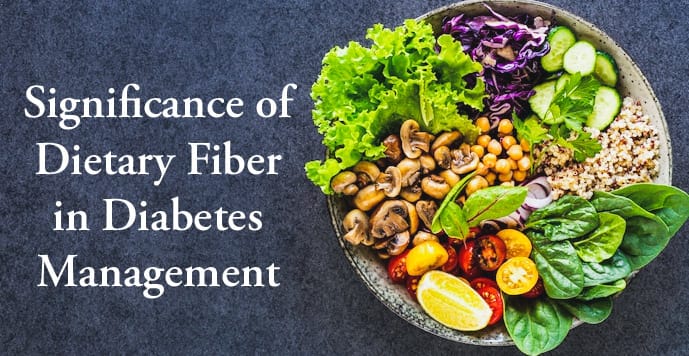No products in the cart.

Significance of Dietary Fiber in Diabetes management
Nowadays with ever increasing talks on many nutrition topics, a lot of changes in the market with overflowing whole grain, millets, legumes products etc, are all proving to have health benefits. One such genre of products that’s taking everyone’s attention is fiber-rich foods.
So, let’s understand the connection between dietary fiber and its role in management of type II Diabetes Mellitus.
What is dietary fiber and how does it work?
We all would have come across the basic nutrients needed by our body, namely Carbohydrates, protein, fats, vitamins and minerals. All these taken in the required quantity helps in keeping the body nourished. Other than the nutrients, there is a need for a few non-nutrients which also have health benefits for the body. One of them is Dietary fiber.
Dietary fiber is found in carbohydrates which are indigestible by the body. They are classified as soluble and insoluble.
Soluble fiber dissolves with water and is altered by bacteria in the stomach. These are found in fruits, vegetables, oats, barley, lentils, nuts, and soya.
Insoluble fiber binds and attracts water which helps with digestion and adds bulk to stools. They are present in whole grains, legumes, nuts, and the skin of vegetables like tomato, cucumber.
How dietary fiber helps with diabetes?
Diabetes is a metabolic disorder caused by defect in action or secretion of the hormone called Insulin. The risk factors for type II diabetes could be genetic or due to poor lifestyle with sedentary habits and unhealthy food choices. One of the solutions for management of diabetes is to correct the food habits.
For management of diabetes using nutrition should help with control of blood sugar levels and help eliminate other risk factors like high blood pressure, cardiovascular diseases etc. This is how fiber helps in diabetes management:
Consumption of fiber can slow down the absorption of glucose, therefore reducing the spike and blood glucose levels.
The soluble fiber is found to reduce postprandial glucose level and also reduce total cholesterol level.
The insoluble fiber is found to reduce the insulin resistance which, in turn, reduces the risk for type II diabetes.
The dietary fiber present in vegetables, fruits, whole grains, and legumes can help in keeping the blood glucose level under control. You can choose low/ medium glycaemic index options based on your glucose readings.
Other than diabetes management, the dietary fiber also helps in secretion of gastric juices and thereby increasing its motility and better digestion. Since the fiber in general is fermentable on the gut though they might not be digested, this fermented fiber helps with regulating gut microbiota which in turn helps in prevention of many lifestyle diseases.
How to opt for more dietary fiber?
Few tips to keep up the dietary fiber on day-to-day intake for people with diabetes:
Opting for whole grains instead of refined ones. You can choose brown rice, red rice, whole wheat flour, millets, quinoa, broken wheat and any unpolished grains.
Since pulses and legumes also contain good amounts of fiber, including them daily can provide added benefits.
Including a wide variety of fruits and vegetables may help too. It’s important to restrict or reduce starchy fruits and vegetables like tubers, sapota, mangoes, bananas etc. in case the blood glucose values are high.
You can include nuts and seeds in limited quantities daily as they are fair to good sources of fiber too.
Other additions in cooking such as coconuts, chillies, herbs, ginger etc. can also contribute to the fiber content.
With diabetes increasing in most populations of the world, it is important to take necessary intervention for both prevention and management of diabetes. As the severity of diabetes increases, the scope for other complications also increases. Therefore let’s keep food as the anchor for better health. After all, as Hippocrates said, “let food be thy medicine and medicine be thy food” is true indeed!

Dietitian




שירותי ליווי באילת לביתך/מלון
Good post. I certainly appreciate this website. Stick with it!
vorbelutr ioperbir
Very interesting info !Perfect just what I was searching for!